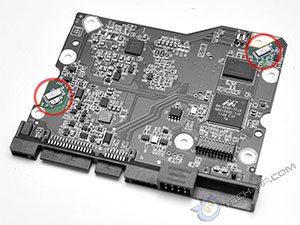Greater Reliability Through Technology
Unlike regular desktop hard disk drives that undergo sample tests, or a few hours of burn-in tests at most; each and every Western Digital RE hard disk drive undergoes two full weeks of extended burn-in tests with thermal cycling. This qualification test ensures that every RE drive is guaranteed to withstand the rigours of 24/7 operation.
Western Digital also packed the RE drive with the latest iterations of various technologies to ensure the drive's reliability, including :
- Enhanced RAFF technology - monitors and corrects both linear and rotational vibration in real time, resulting in a significant performance improvement in high vibration environments over the previous generation of drives.
- Multi-axis shock sensor technology - automatically detects the subtlest
shock events and compensates to
protect the data.
- Dual actuator technology - improves the positional accuracy over the data tracks. The primary actuator provides coarse
displacement using conventional
electromagnetic actuator principles.
The secondary actuator uses
piezoelectric motion to fine tune the
head positioning to a higher degree
of accuracy. This feature is only available in models of 2 TB capacities and above.
- StableTrac technology - reduces system-induced vibration and stabilize the platters for more accurate tracking, by securing the motor shaft at both ends. This feature is also only available in models of 2 TB capacities and above.
The more stringent reliability requirement is also the reason why the Western Digital RE isn't using their Advanced Format Technology, which they rolled out way back in 2010. That's why the 4 TB RE drive requires five platters, instead of just four. Western Digital only expects to transition their enterprise drives to AFT in the next two years.
With a mean time before failure (MTBF) of 1.2 million hours, only a single RE drive out of a hundred is expected to fail after 16 months of non-stop operations. This is about the standard MTBF for enterprise-grade drives, but is much higher than that of desktop hard disk drives. If reliability is what you are after, than such features and qualification tests are critical to ensure high MTBF.
TLER Support
All modern hard disk drives are designed to automatically correct read and write errors and protect against further data corruption by remapping bad sectors with spare sectors. This remapping process can take anywhere from a few seconds to several minutes to accomplish, depending on the number of bad sectors and the drive's workload.
Unfortunately, RAID controllers are designed to drop hard disk drives from a RAID array if they are unresponsive for more than a few seconds. This is done in the assumption that such a drive has either malfunctioned or is no longer reliable. Depending on the type of RAID array, it can cause the array to lose its data redundancy or force a rebuild of the RAID array from parity data.
To prevent this, the Western Digital RE supports TLER, which is short for Time-Limited Error Recovery. It limits the read error recovery process in the RE to just 7 seconds, after which the error recovery process is aborted. This prevents the RAID controller from marking the drive as unreliable and dropping it from the RAID array. The RAID controller can also take over whatever error recovery is left to perform.
You can modify thus default setting using the Western Digital Time Limit Error Recovery Utility (WDTLER.EXE). Many RAID controllers have timeout delays that are longer than 7 seconds, and it is recommended that TLER be delayed for as long as possible. As long as TLER is set to timeout at least 1 second before the RAID controller times out, it will prevent the RAID controller from dropping the drive.
TLER has no performance implications when used outside of RAID arrays. However, it prevents the error recovery process from completing and because there is no RAID controller to take over the error recovery process, detected bad sectors may not be replaced in time. Therefore, it is not advisable to use TLER-enabled drives in non-RAID situations. You can, of course, solve the problem by turning off TLER.
Support Tech ARP!
If you like our work, you can help support out work by visiting our sponsors, participate in the Tech ARP Forums, or even donate to our fund. Any help you can render is greatly appreciated!
Page |
Topic |
|
1 |
||
2 |
||
3 |
• The 4 TB Western Digital RE |
|
4 |
• Peeking Under The PCB |
|
5 |
• Better Reliability Through Technology |
|
6 |
• Testing The 4 TB Western Digital RE |
|
7 |
||
8 |
||
9 |
||
10 |
||
11 |
||
12 |
||
13 |
<<< Peeking Under The PCB, Connectors & Jumpers, Breather Holes : Previous Page | Next Page : Testing The 4 TB Western Digital RE, Maximum Surface Temperature >>>







 Add to Reddit
Add to Reddit

